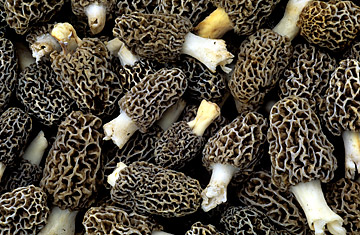
Fungus that grows on rot might not, at first, seem the perfect image of our culinary ideals. And yet, if there is one food that can most perfectly symbolize America's values in the way we eat and cook, it might well be mushrooms. All kinds of mushrooms: the otherworldly morels that have started to appear in the moist morning of the Great Lakes, yellowfoot chanterelles in the steep woods of the northern states, rugged Hen of the Woods mushrooms on the East coast. Their variety is infinite, their appearance beguiling, the taste, when fresh, ineffable. The fact is that we are now living in the Mushroom Millennium.
And that's a good thing. Every restaurant not located in a desert has access to some kind of local mushrooms, frequently foraged by some half-savage guru, half man and half sasquatch, who tracks through the forest primeval like some latter day Deerstalker. The mushrooms he turns out, still with the rich loam of the forest floor sticking to them, smell of pure nature; and what's more, they taste like it too
Moreover, for all their exoticism, they're still pretty cheap. Even a mom-and-pop restaurant can make a mood-altering dish with some woodsy mushrooms, roasted up with salt and served along side a gelatinous hunk of braised short rib. A few fresh chanterelles go in a little omelet with some small spring asparagus, and you've got an appetizer of unsurpassable elegance. Unlike their fetishized cousins the truffles, people still use mushrooms as staple items and not luxuries — a practice that might not persist if they become more popular. They add a level of flavor and texture to everything they touch, and there's a variety for nearly every use, from the delicacy of enoki to the almost obscene potency of portobellos. Compared with the crappy little button mushrooms you see at the supermarket, de-natured and nude, and grown somewhere far from the forest floor, they represent an instant ticket to a better vision of life. If a restaurant, you can charge for that; if cooking at home, you can brag on it. Either way, it costs little. And of course there are no calories to speak of in mushrooms, so even the most ascetic of eaters can consume them with abandon. They're apparently loaded with various unpronounceable anti-oxidants too, so that's another benefit.
All these facts haven't been wasted on foodies, who have even go so far as to start taking foraging classes in many cities. This isn't something I would personally recommend; there are a lot of mushrooms that look alike, and some of them will kill you. Maybe stick to nasturtium and wild sage in your foraging expeditions. On the other hand, you might end up opening up the Doors of Perception and understanding the cosmos. So that would be a beneficial effect — at least if you are eating alone.
The mere fact that it's possible to get wild mushrooms just by walking around on public land is exciting though. It speaks to the glamour that these humble organism carry with them, despite their ancient, primitive strangeness. (Fungi are thought by biologists to date back one and a half billion years.) Best of all, beyond a few familiar types like buttons and porcinis, most of them are little known to the average eater. "Supermarket mushrooms are often dried out and generic," says Adam Sappington of The Country Cat in Portland. "They often add more water content to a dish than actually elevate the plate in both flavor and aesthetics. All wild mushrooms hold a special place in my heart and I can mark the seasons by them." I know the truth of this for a fact, as I recently saw Adam at a demo we were doing. He beckoned me into his room and bade me look at a zipped up thermal bag he had smuggled in his suitcase. "Check these out," he said, conspiratorially. Inside the bag were a trove of hand-picked mushrooms he had gathered a day earlier, dark and moist and fragrant with unburied earth and the piquant musk of absolute freshness. Payday!
What wild mushrooms you're likely to find depends on where you live, and when you look — which as Adam says, is part of what people love about them. I myself love the meatiest of mushrooms, the rich plump morels that sit like sweetbreads on my plate, and the woodsy Hen of the Woods that seem to have been roasted in the earth by a benevolent Mother Nature. I'm not saying that I would go out foraging for them myself. But somebody will. After a billion and a half years, the mushroom's time has come.
Ozersky is a James Beard Award–winning food writer and the author of The Hamburger: A History. You can listen to his weekly show at the Heritage Radio Network and read his column on home cooking on Rachael Ray's website. He is currently at work on a biography of Colonel Sanders.
